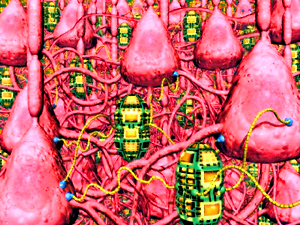Artificial Brain Cells

The central cylinder of each Brainbot houses a computer that contains a storehouse of information equalling many large libraries, and instruments for recording "surface thoughts." Billions of these nanobots are in communication with one another, and with the brain cells, creating a secondary brain. I (*), personally, do not believe that it will ever be possible to download a "conscious" diesmbodied mind into a computer. However, it will be possible to place a robotic brain into a human skull, composed of billions of microscopic nanobots. This would give each human being two brains; an electro-chemical wet-brain, and a dry, purely electronic digital brain. When the two brains interact, a third brain may emerge with qualities for which we can only speculate. (RR: As was the previous image, this one is based on an interpretation of existing and potential nanoscale technology.)
(*) Artist, Tim Fonseca.
As with the previous picture, I will post the others in this series over time. To see it all now, visit the Nanotechnology Now Gallery.









